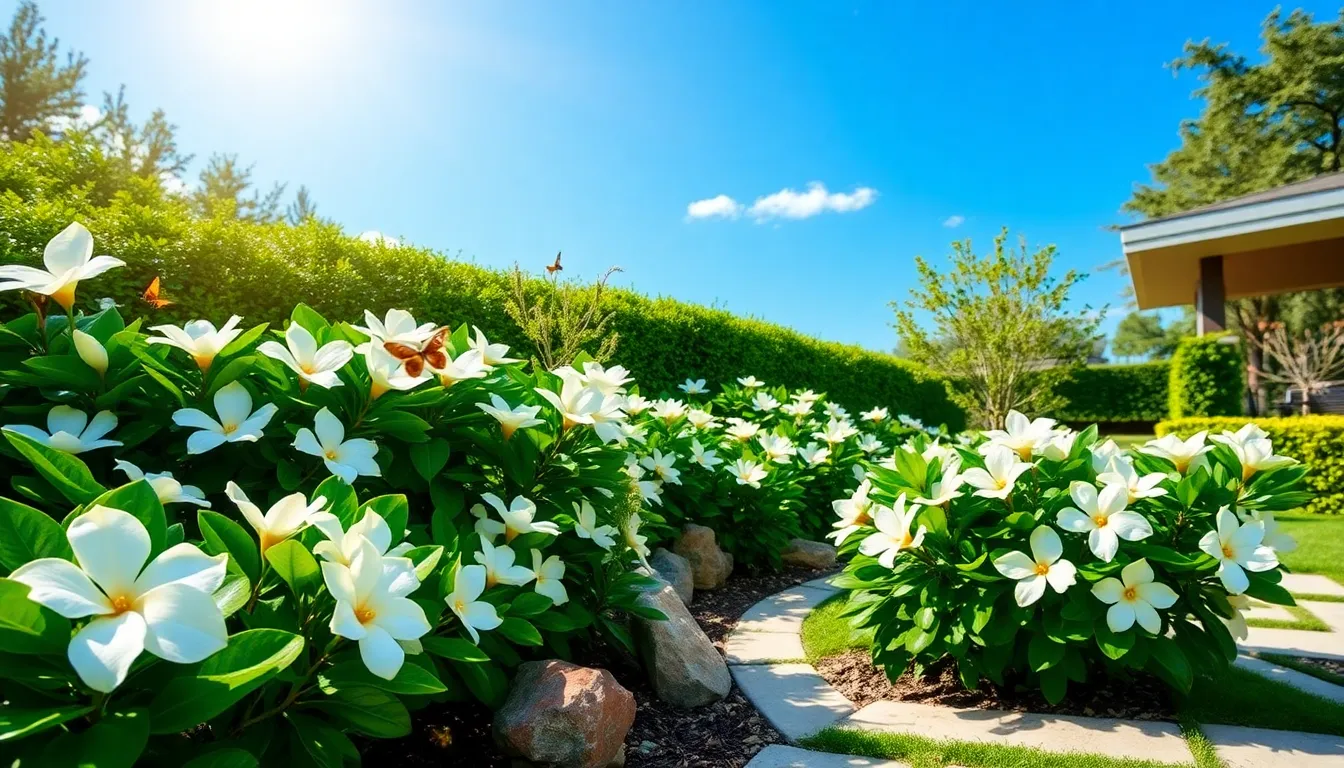When it comes to elevating your garden from ordinary to extraordinary, gardenias are the secret weapon you didn’t know you needed. These aromatic beauties don’t just look stunning, they practically beg to be the centerpiece of your landscaping plans. Think fragrant blooms, glossy leaves, and a touch of southern charm. If you’re ready to jump into the world of gardenia landscaping, hold onto your gardening gloves. Let’s explore how to make these enchanting plants shine in your outdoor space, while keeping it fun and professional, of course.
Gardenia Landscaping Ideas

Gardenias are not just pretty faces in the world of landscaping. With their glossy green leaves and stunning white blooms, they bring a sense of elegance and fragrance that few plants can rival. Often associated with the South, they thrive in warm climates but can also adapt to various conditions if cared for properly.
Characteristics of Gardenias
Gardenias typically bloom from late spring through summer, offering a delightful perfume that fills the air. Their creamy white flowers are star-shaped and exhibit a striking contrast against their dark green foliage. In terms of size, gardenia bushes can vary, reaching heights of anywhere from 2 to 8 feet, depending on the variety.
Benefits of Gardenias
One of the most significant advantages of planting gardenias is their fragrance. A single plant can envelop your garden in a sweet scent, making outdoor gatherings much more enjoyable. Besides being a sensory delight, these plants also attract beneficial pollinators like bees and butterflies, making your garden a haven for wildlife. Plus, they provide year-round interest, evergreen leaves remain lush and vibrant even in winter.
Designing Your Gardenia Landscape
Crafting a gardenia-centric landscape is like being an artist with a blank canvas. Before diving in, consider the following design principles to ensure your garden shines:
Choosing the Right Location
Gardenias flourish in locations with partial shade to full sun. But, they prefer some protection from harsh afternoon sunlight, especially in hotter climates. Finding the right spot can make a world of difference in their growth and bloom quality.
Size and Spacing
When planting gardenias, it’s crucial to leave enough space for them to grow. A general rule of thumb is to plant them about 3 to 4 feet apart. This spacing allows for adequate air circulation and prevents overcrowding.
Layering and Height Variation
Consider using gardenias as a focal point in layers. Plant taller varieties toward the back of a border and shorter ones in front. This staggered approach not only enhances visual appeal but also creates depth in your landscape.
Complementary Plants for Gardenias
To really make gardenias pop, it helps to have the right companions in your garden. Select plants that complement their beauty and thrive in similar conditions.
Ideal Companions
- Azaleas: Both gardenias and azaleas prefer acidic soils and partial shade, making them perfect partners. Their vibrant colors can enhance the classic white blooms of gardenias, creating a stunning visual contrast.
- Camellias: These are another fantastic pairing. The robust blooms of camellias add layers and textures, enriching the landscape while thriving in similar conditions.
- Ferns: For a touch of greenery, ferns work wonders. Their delicate fronds provide an attractive backdrop, allowing the bold flower display of gardenias to shine even brighter.
Avoiding Competitors
While choosing companion plants, avoid overly aggressive varieties that might overshadow your gardenias. Plants that thrive in completely different soil types or light conditions can lead to competition for nutrients.
Gardenia Care Tips for a Thriving Landscape
Caring for gardenias isn’t overly complicated, but they do have specific needs to keep them happy and healthy.
Watering
Gardenias thrive in constant moisture but dislike sitting in water. Water them deeply, ensuring the roots are well-hydrated, but allow the top layer of soil to dry out slightly between waterings.
Soil and Fertilization
Opt for well-draining, acidic soil rich in organic material to give your gardenias a boost. Annual fertilization during the spring, using an acid-based fertilizer, helps them flourish and encourages flowering.
Pruning
To promote bushy growth and remove any dead or unsightly stems, regular pruning is essential. Prune gardenias after their blooming period ends to keep them healthy and vibrant.
Creative Gardenia Landscaping Ideas
Let’s get those creative juices flowing. Here are some imaginative ways to incorporate gardenias into your landscaping:
Gardenia Borders
Use gardenias as low hedges along pathways or garden borders. Their lush foliage and fragrant flowers provide a beautiful border effect, guiding visitors through your garden.
Container Gardening
For those with limited space, consider planting gardenias in stylish containers. Place them near patios or entryways to welcome guests with their delightful scent and visual appeal.
Mixed Beds
Create a mixed bed with gardenias at the center, surrounded by complementary plants. This not only draws attention but also creates a lively habitat for local fauna.
Incorporating Gardenias in Different Garden Styles
Gardenias can seamlessly fit into various garden styles, adapting to the aesthetics you desire:
Formal Gardens
In formal gardens, gardenias work wonders as structured hedges or focal points. Their neatly tended appearance aligns perfectly with the symmetry typical in formal landscapes.
Cottage Gardens
For a more relaxed vibe, gardenias can be sprinkled throughout cottage gardens, lending their fragrance to densely packed flower beds. They harmonize beautifully with other classic cottage plants.
Tropical Gardens
If tropical vibes are your goal, gardenias can join forces with hibiscus and palm trees. Their lush foliage complements the vibrant colors typically found in tropical landscapes, creating a serene escape.

